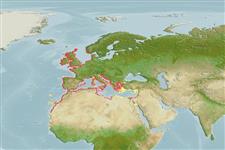Common names from other countries
Classification / Names / Names
Populärnamn | synonymer | Catalog of Fishes (gen., sp.) | ITIS | CoL | WoRMS
Environment: milieu / climate zone / depth range / distribution range
Ekologi
; brackvatten; djupintervall 0 - 1 m (Ref. 105875). Tropical, preferred 15°C (Ref. 107945); 61°N - 13°N, 18°W - 36°E
Eastern Atlantic and Mediterranean: from Norway to United Kingdom, France, Spain, Portugal, Morocco, Mauritania, and Senegal, including the Mediterranean, from Spain, France, Monaco, Italy, Slovenia, Croatia, Bosnia and Herzegovina, Montenegro, Albania, Greece, Turkey, Cyprus, Syria, Lebanon, Israel Egypt, Libya, Tunisia, and Algeria. Introduced in Azores Islands. Temperate to tropical.
Length at first maturity / Size / Vikt / Age
Maturity: Lm ? range ? - ? cm Max length : 8.0 cm SHL hane/ej könsbestämd; (Ref. 109255); common length : 6.0 cm SHL hane/ej könsbestämd; (Ref. 437)
Found in sheltered bays, estuaries and lagoons (Ref. 106936). Tends to bury itself in sand, muddy gravel, clay (Ref. 78574) or silty mud (Ref. 107087) and is found on the lower shore and shallow sublittoral (Ref. 78574). Feeds on phytoplankton and detritus (Ref. 107087).
Life cycle and mating behavior
Könsmognad | Reproduktion | Lek | Ägg | Fecundity | Larver
Members of the class Bivalvia are mostly gonochoric, some are protandric hermaphrodites. Life cycle: Embryos develop into free-swimming trocophore larvae, succeeded by the bivalve veliger, resembling a miniature clam.
SAUP Database. 2006. (Ref. 356)
IUCN Red List Status (Ref. 130435)
CITES status (Ref. 108899)
Not Evaluated
Not Evaluated
Human uses
Fiskeri: kommersiell
FAO - Vattenbruk: produktion, species profile; fiskeri: landings, species profile | FishSource | Sea Around Us
Verktyg
Internet-källor
Estimates based on models
Preferred temperature
(Ref.
115969): 9.4 - 21.1, mean 18.1 (based on 876 cells).
Resiliens
Hög, lägsta populationsfördubblingstid mindre än 15 månader (K=0.44-0.52).
Vulnerability
Low to moderate vulnerability (30 of 100).
